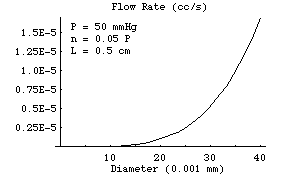|
|
Poiseuille's Law: Graph Exploration of Radial Dependence
We show next the graph of the
power law relation between flow and diameter (and, equivalently, radius). This graph is typical of a power law. Similar to the linear relation for pressure, this has an increasing graph. If the diameter gets arbitrarily large, then the flow does as well. Also, as the diameter gets smaller, the flow decreases. This corresponds to the physically meaningful result that no fluid can flow through a closed tube. It is very important that the shape of this curve is convex (curved upward). This results in the valuable sensitivity of the flow to the size of the diameter. Physiologically, this is the most important factor in controlling the rate blood flows through your body.
|
